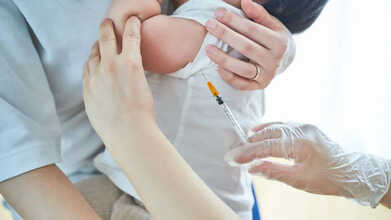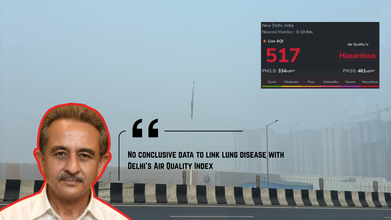- Health Conditions A-Z
- Health & Wellness
- Nutrition
- Fitness
- Health News
- Ayurveda
- Videos
- Medicine A-Z
- Parenting
One In 31 Kids Diagnosed With Autism, CDC Reveals Alarming Data Contradicting RFK Jr.'s Claims

Autism diagnoses for children in the United States continue to rise, with the latest data from the Centers for Disease Control and Prevention (CDC) indicating that one out of every 31 eight-year-olds have been diagnosed with autism spectrum disorder (ASD). The findings, published in the CDC's Morbidity and Mortality Weekly Report, are a low-key but significant improvement over previous years and come at a time when the disease is facing heightened political scrutiny, including from the administration of President Donald Trump and Health Secretary Robert F. Kennedy Jr.
While the CDC attributes this steady rise to improved screening, increased awareness, and broader access to diagnostic care, Kennedy has introduced fresh unsubstantiated claims of a connection between autism and exposures to the environment and vaccines—despite decades of contradiction from empirical evidence suggesting no such association. His comments have stoked controversy surrounding the causes of autism even as experts emphasize that the evidence must be reflected in more comprehensive policies and support systems, not fear or misinformation.
Is Autism Really on the Rise Or Early Detection?
In its recent report both pointing to gains in early detection and persistent issues with autism spectrum disorder (ASD), the Centers for Disease Control and Prevention (CDC) revealed that autism rates in the United States have reached an all-time high. Through 2022, approximately 1 in 31 U.S. 8-year-olds had an autism diagnosis—an increase from 1 in 36 two years before. Though some have called this a "public health epidemic," health care providers and scientists credit the trend to a more longer-term shift in diagnostic patterns, increased awareness, and increasing access to services, especially within historically disenfranchised populations.
The CDC's latest biennial surveillance report, published in the Morbidity and Mortality Weekly Report, includes a comprehensive picture of autism prevalence across the country. Using data collected from several Texas, Georgia, and California communities, the findings show significant regional variation. For example, in one San Diego metropolitan community, 1 in 19 children had been diagnosed with autism—the highest rate in the study.
Of note, these rises are not always a reflection of a rise in the prevalence of children with autism, but rather an increase in the ability to identify it, particularly at earlier stages in life. According to the CDC, enhanced screening tools, parent and pediatrician education campaigns, and community-based interventions have all contributed to this diagnostic shift.
The report comes on the heels of autism having received new political attention. President Donald Trump and Health and Human Services Secretary Robert F. Kennedy Jr. placed autism at the center of their healthcare agenda. Kennedy, who has long drawn criticism for linking autism with vaccines—a myth that has been often debunked by the scientific world—called the condition an "epidemic running rampant."
Contrary to Kennedy's assertions, the CDC and senior health leaders maintain that increases in autism diagnosis are primarily due to positive trends in detection and awareness, rather than an explosion of cases with environmental or medical causes.
Kennedy's call for new investigations into vaccines and autism has raised alarm among advocacy groups and scientists. The decades-long, peer-reviewed push against the myth that vaccines cause autism has demolished the trope. According to the CDC, vaccines remain safe and essential to public health.
This rhetoric does more harm than good," stated Christopher Banks, president and CEO of the Autism Society of America. "Prevalence data should drive equity and access—not fear, misinformation, or political rhetoric.".
Perhaps most notably, the CDC report highlights the growing trend of autism diagnoses in children of color. Traditionally disproportionately diagnosed in white, affluent communities, ASD increasingly is being diagnosed in Black, Hispanic, and Asian children. The trend, first reported in the 2020 CDC report, continues, a sign of growing outreach and access to care in historically underserved communities.
In fact, autism now happens less frequently in upscale neighborhoods than in socially disadvantaged communities—a reversal of the decades-ago trend. The CDC emphasized that the trend reversal is likely a result of concerted efforts to reduce gaps in early screening and diagnostic services, and not because there is any increased biological risk in some communities.
Autism remains significantly more common in boys than girls. In 2022, autism was diagnosed in boys at a rate 3.4 times higher than girls. While the disparity has lessened in recent years, scientists caution that the disparity is not wholly due to improved diagnostic practices in girls. The nuance and lower disruptive impact of ASD presentation in women—frequently more subtle and less disruptive—can still lead to underdiagnosis or misdiagnosis.
Local variation in autism prevalence also tends to correlate with the existence of early intervention services. California, for example, has an excellent program training pediatricians to screen for early signs of autism and providing state-funded regional centers for kids with developmental disorders. These models that are based within communities provide roadmaps for the enhancement of autism identification and treatment systems across the country.
Likewise, Puerto Rico's recent investment in public autism awareness campaigns had a profound influence on diagnostic rates. Children born after the island-wide early detection initiative was initiated had one of the highest rates of diagnosis among their age group, a reflection of the effectiveness of preventive public health initiatives.
While the slight uptick in autism rates may sound alarming, health professionals urge the public to interpret the numbers with caution. “This is not an epidemic,” said one CDC epidemiologist familiar with the report. “What we’re seeing is the fruit of years of advocacy, education, and systemic change.”
Experts and autism advocacy leaders reinforce that message. "This entire generation of children is not damaged," said the Autism Society's Banks. "They are being seen, heard and served more than ever before."
Ayush Mark Explained: What Is This New Global Standard Label For Traditional Medicine?

Credits: Canva
Prime Minister Narendra Modi unveiled the Ayush Mark at the Second WHO Global Summit on Traditional Medicine on Friday. The Ayush Mark is envisioned as a global standard for quality Ayush products and services. The WHO Global Summit on Traditional Medicine was held at Bharat Mandapam from December 17 to December 19, 2025, with this year’s theme, “Restoring balance: The science and practice of health and well-being.” Speaking at the closing ceremony, PM Modi highlighted India’s rising leadership in promoting traditional medicine as an evidence-based, integrated, and people-focused part of global health systems.
Alongside the Ayush Mark, PM Modi also introduced the My Ayush Integrated Services Portal (MAISP), the central digital platform of the Ayush Grid, released a commemorative Ashwagandha postal stamp, the WHO technical report on Yoga training, and the book “From Roots to Global Reach: 11 Years of Transformation in Ayush.” He also presented the Prime Minister’s Awards for Outstanding Contribution to the Promotion and Development of Yoga, recognizing both national and international individuals and organizations for their exceptional service.
Speaking at the event, he said, “Over the past three days, experts from across the world in traditional medicine have held meaningful discussions here. I am glad India is providing a strong platform for this, and the WHO has actively participated. It is our good fortune and a matter of pride that the WHO Global Centre for Traditional Medicine has been established in Jamnagar, India. The world entrusted us with this responsibility with great confidence at the first Traditional Medicine Summit.”
What Is The Ayush Mark?
The Ayush Mark is a label issued by the Ministry of Ayush for Ayurveda, Yoga and Naturopathy, Siddha, Unani, and Homoeopathy products and services. The Ayush Mark Certification Scheme has been run by the Quality Council of India (QCI) since 2009.
Products and services carrying the Ayush Mark follow quality manufacturing practices, use standard raw materials, and undergo safety testing. The Ayush Mark and its two previous certification levels have existed for several years. The new label builds on them and aims to set a global benchmark for traditional medicine products and services. Earlier certifications included the Ayush Standard Mark and the Ayush Premium Mark.
The Ayush Standard Mark follows Good Manufacturing Practices (GMP) for Ayurvedic, Siddha, and Unani medicines under Schedule T of the Drugs and Cosmetic Rules, 1945. The Ayush Premium Mark is aligned with WHO GMP guidelines for herbal medicines.
Dr Tedros Adhanom Ghebreyesus, WHO Director-General, also attended the WHO Global Summit on Traditional Medicine. He praised PM Modi for elevating traditional medicine to a global platform. Dr Tedros commended India for turning vision into action, calling the country a global leader in transforming traditional medicine from heritage to evidence-informed practice. He highlighted landmark initiatives like the establishment of the Ministry of Ayush and the WHO Global Centre for Traditional Medicine in Jamnagar, noting these efforts have strengthened the integration of traditional medicine into health systems, research, and policy, supporting universal health coverage and sustainable development worldwide.
Global Recognition and Impact of Ayush Mark
The Ayush Mark is not just a certification but a step toward placing Indian traditional medicine on the world stage. By setting internationally recognized quality benchmarks, it aims to boost confidence among global consumers and practitioners, encouraging the adoption of Ayurveda, Yoga, Naturopathy, Siddha, Unani, and Homoeopathy products and services worldwide. This initiative reinforces India’s role in shaping evidence-based, safe, and sustainable traditional medicine practices across borders.
What Is Denmark’s Childhood Vaccination Schedule That RFK Jr. Is Considering For The U.S.?

Credits: Canva
The Trump administration is reportedly preparing to announce changes to the childhood immunisation schedule early next year, with a proposal that would recommend fewer vaccines and bring U.S. policy closer to Denmark’s model. A source familiar with the discussions told NewsNation correspondent Libbey Dean that the revised schedule, expected next year, would involve fewer shots and would be “more in line with Denmark’s vaccination schedule,” according to The Hill. This has raised an important question: what does Denmark’s vaccine schedule look like, and is it realistic for the U.S. to follow it?
Denmark Vaccine Schedule: What Is It?
Denmark runs a clearly defined childhood vaccination programme that is free and voluntary, aimed at protecting children from serious infectious diseases. Infants are given combination vaccines that cover diphtheria, tetanus, whooping cough, polio, and Haemophilus influenzae type b, along with the pneumococcal vaccine, at 3, 5, and 12 months. Children receive their first dose of the measles, mumps, and rubella (MMR) vaccine at 15 months, with a second dose at 4 years.
A booster shot for diphtheria, tetanus, whooping cough, and polio is administered at 5 years. Around the age of 12, both boys and girls are offered the HPV vaccine to reduce the risk of cancers linked to the virus. Vaccines for chickenpox, rotavirus, hepatitis A, or meningococcal disease are not routinely included in Denmark’s standard schedule, according to official guidance from the Danish Health Authority’s Childhood Vaccination Programme.
RFK Jr. Is Considering Denmark Vaccine Schedule For US
Reports suggest that the Department of Health and Human Services (HHS) is exploring additional changes to federal childhood vaccine recommendations, with a focus on aligning them more closely with those followed by other developed nations, especially Denmark, as per The Washington Post. This discussion comes after a meeting earlier this month of the CDC’s Advisory Committee on Immunization Practices (ACIP), where childhood vaccine schedules in the U.S. and Denmark were reviewed and adjustments to the U.S. schedule were made. It was followed by a memorandum from President Trump directing HHS to begin a “process to align U.S. core childhood vaccine recommendations with best practices from peer, developed countries.”
Denmark Vaccine Schedule: What Happens If the US Adopts It?
If the U.S. were to adopt Denmark’s schedule in full, it would result in fewer vaccines being recommended for children up to age 18. When comparing vaccines that are universally advised in both countries, Denmark’s programme covers protection against 10 diseases, while the U.S. schedule includes vaccines for 16 diseases, following the removal of hepatitis B from universal recommendations. The additional vaccines recommended in the U.S. address respiratory syncytial virus (RSV), rotavirus, varicella, hepatitis A, and meningococcal disease. Although the U.S. advises more childhood vaccines than many comparable countries, Denmark stands out for recommending fewer than most. Data from the European Centre for Disease Prevention and Control (ECDC) vaccine scheduler shows that none of the other 29 ECDC member countries limits its routine childhood schedule to just 10 diseases. Several countries, including Germany, Greece, Ireland, Italy, and Poland, recommend vaccines against 15 or more diseases, while Austria’s schedule covers 17 diseases, which is even more than the U.S. currently recommends.
Every country follows its own process when setting vaccine recommendations, shaped by its specific circumstances. Childhood immunisation schedules are built over years by reviewing available evidence and weighing factors such as healthcare systems, insurance coverage, public health infrastructure, and national priorities. This explains why vaccine schedules vary across countries, and so far, no developed nation has based its decisions solely on what another “peer” country does.
Importantly, Denmark’s approach is not based on a different interpretation of vaccine science or effectiveness. Instead, Danish health authorities prioritise recommending vaccines that significantly lower the risk of death or serious illness in children. For instance, while rotavirus infections do occur among children in Denmark, they rarely result in death or long-term harm in a setting with universal healthcare access, strong medical systems, and lower inequality than in the U.S. By contrast, neighbouring countries such as Norway and Finland do include the rotavirus vaccine in their routine schedules, as does the U.S., where before the vaccine was introduced, rotavirus caused an estimated 2.7 million infections each year, leading to 55,000 to 70,000 hospitalisations and 20 to 60 deaths among children under five.
'No Direct Link Between Lung Disease And Air Pollution,' Says Minister; But Studies Say Something Else

Credits: Wikimedia Commons and AQI.in
Delhi yet again woke up to a thick smog blanketed Saturday morning. The AQI stood at 380 for the city, which puts it under the 'very poor' category, as of 7am, according to the Central Pollution Control Board (CPCB). Several parts of the city also recorded with in the 'severe' limits of air pollution, with multiple stations recording AQI above 400. These areas include Anand Vihar and Sarai Kale Khan recorded 428 AQI, ITO recorded 429, Akshardham recorded 420, Ashok Vihar recorded 407, and Rao Tularam Marg recorded 403.
While GRAP Stage IV is enforced in the capital to combat the pollution problem, amid this, Minister of State for Environment and Climate Change Kriti Vardhan Singh told the Rajya Sabha on Thursday that there is no direct correlation between higher Air Quality Index or AQI levels and lung diseases. He said that there is no "conclusive data" to establish such a link. However, he did say that air pollution is one of the "triggering factors" for respiratory ailments and associated diseases.
What Do Doctors And Research Say On The Link of Lung Diseases And Air Pollution
"Lung cancer is no longer a smoker’s but a breather’s disease," said Dr Arvind Kumar, chairman, Lung Transplant, Chest Surgery and Oncosurgery at Medanta, Gurugram, as reported by The Indian Express. He treated a 31-year-old patient from Ghaziabad with lung cancer, who had never smoked in her life.
"Younger non-smokers are being diagnosed. And there are as many women as men. This indicates that lung cancer is no longer a smoker’s but a breather’s disease. While we talk of particulate matter, the ambient air in the urban environment is full of carcinogenic gases. And this is emerging as a real threat to everybody," the doctor said.
Dr Shivanshu Raj Goyal, a pulmonologist and Associate Director Pulmonary Medicine at MAX Healthcare in Gurugram and Delhi, in an Instagram video said that breathing this toxic air is equivalent to smoking 20 cigarettes in a day. The doctor starts his video with a rather strong statement, "At present, no one in Delhi-NCR is a non-smoker."
The doctor also states that on an average, a person breathes around 20,000 times in a day, so it means we are inhaling the toxic air at least 20,000 times a day.
As per a 2017 study titled Pulmonary Health Effects of Air Pollution, it is clear that lung cancer could be exacerbated due to exposure to a variety of environmental air pollutants with greatest effects due to particulate matter (PM), ozone, and nitrogen oxides.
As per Action on Smoking and Health (ASH), a cigarette contains nicotine, and tar, which is composed of chemicals like benzene, benzopyrene, and the gas includes carbon monoxide, ammonia, dimethyl nitrosamine, cadmium, formaldehyde, hydrogen cyanide and acrolein. Some of these marked irritant properties are also carcinogen, meaning, it can cause cancer.
Whereas Air Pollution contains pollutants like particulate matter PM 10 and PM 2.5, ozone, nitrogen dioxide, carbon monoxide, cadmium and sulfur dioxide. Air pollution, which is often a byproduct of combustion or released from vehicle exhaust also contain formaldehyde, benzopyrene, and benzene. As per the World Health Organization (WHO), the pollutants contain carcinogens, and the outdoor air pollution is in fact classified as Group 1 carcinogen.
Read: Breathing Delhi's Toxic Air Is Like Smoking 20 Cigarettes A Day
Common Chemicals We Inhale When We Breathe Delhi's Toxic Air And When We Smoke A Cigarette
Carbon Monoxide: a poisonous, flammable gas that is colorless, odorless, tasteless, and slightly less dense than air.
Benzene: a colorless and highly flammable liquid with a sweet smell, and is partially responsible for the aroma of gasoline.
Cadmium: a soft, silvery-white metal (atomic number 48) that is toxic and naturally found in the environment, but human activities have increased its levels. It is used in products like batteries, pigments, and coatings, and exposure can occur through tobacco smoke, contaminated food, and occupational inhalation. Cadmium is a known human carcinogen that can damage the kidneys and bones.
Formaldehyde: a colorless, flammable gas with a strong odor, whose exposure could cause cancer.
Benzopyrene: a group of organic compounds known as polycyclic aromatic hydrocarbons. It is a colorless crystalline solid found in sources like cigarette smoke, coal tar and is a known carcinogen that can cause cancer and other health problems like skin rashes and bronchitis, and exposure requires medical attention for any symptoms.
© 2024 Bennett, Coleman & Company Limited

